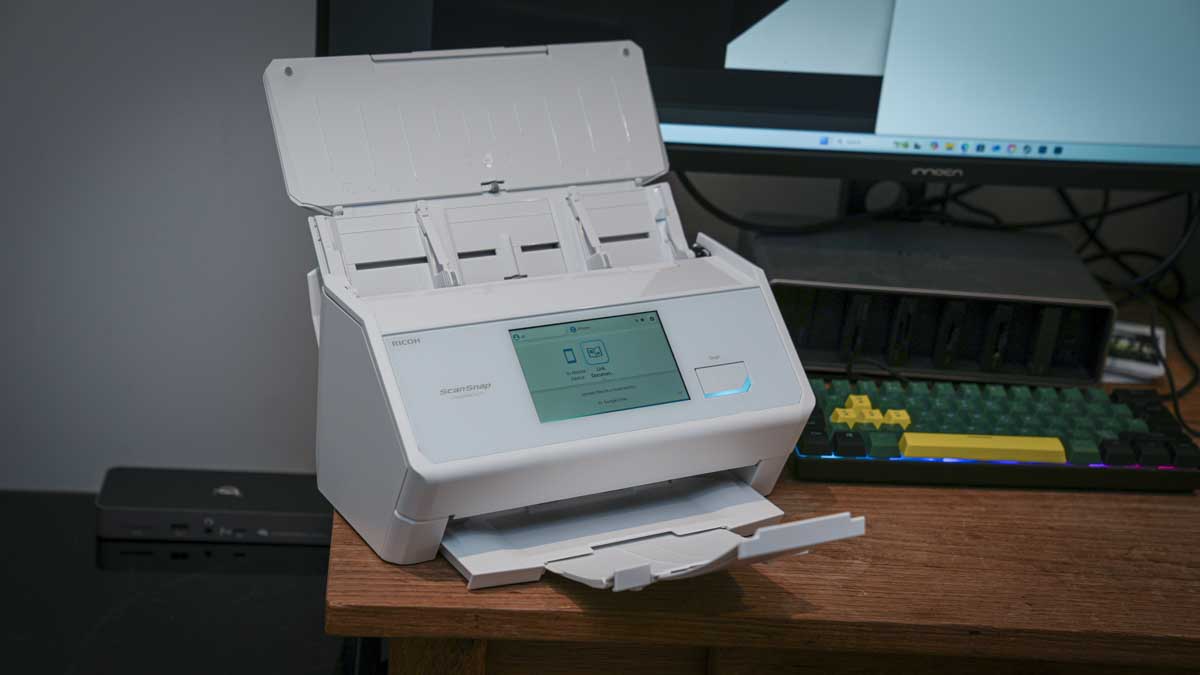TechRadar Verdict
The ingenious design enables you to quickly scan multiple pages in one go, alongside basic document and mid-quality photo scanning. The software is simple to use and, with that large touchscreen, it's all easy to navigate through the desktop or mobile software, making it a great option for any home office or small business.
Pros
- +
Excellent connectivity options
- +
High-speed duplex scanning
- +
Easy-to-use touchscreen interface
Cons
- -
No flatbed scanning
- -
Slower at maximum resolution
- -
Photo resolution mediocre
Why you can trust TechRadar
ScanSnap iX2500: 30-second review
The Ricoh ScanSnap iX2500 follows in the line of superb desktop scanning machines that I've looked at previously, including the ScanSnap iX1300. Here, the overall design has been refined with a large touchscreen and up to a 100-page document auto-feeder that just makes your life scanning documents that much quicker and easier.
Every aspect of this document scanner has been enhanced, including the connectivity options, which now include Wi-Fi 6, USB-C and Bluetooth options, meaning you can connect to almost any device. With software that you can install on Windows, Mac, iOS and Android devices, giving you plenty of options over the way you control the scanning options and settings.
When it comes to speed, the fact that it now features a 100-page auto-feed helps to speed up any scanning process, and with a 45 PPM simplex and 90 IPM duplex scanning, the speed at which you can get through documents is surprisingly fast.
What I really liked about the auto-feed was that even with relatively old documents that were creased, it was able to individually pick them out and scan them through either a single or double page.
The other aspect that impressed was that it was able to handle a mixed-size batch with relative ease, so if you have some A4 and A5 sheets, rather than having to do each size separately, you can bundle them all together, and the scanner is clever enough to work out the difference.
Over a flatbed scanner, the small ScanSnap iX2500 takes up a small footprint, meaning you can place it on a shelf or somewhere out of the way until it's needed, as it's unlikely that a document scanner is something you'll be using on a day-to-day basis.
The other aspect is the tight integration with Google Drive as well as other cloud options, meaning that as you scan, you can directly upload to a cloud folder so that others can access the scans, or you can just keep the documents securely stored for later use.
Sign up to the TechRadar Pro newsletter to get all the top news, opinion, features and guidance your business needs to succeed!
The large 5-inch touchscreen works exceptionally well enabling easy navigation through settings and scanning. This is complemented by an equally impressive app, which again enables you to configure all areas of the scanning process.
Alongside the scanning hardware and mobile app is a decent suite of software with OCR and PDF tools, which enable you to convert your scanned images into editable documents that you can update and search within your chosen application.
While you might not be able to scan an old book, the fact that it can scan multiple pages quickly and easily and in a multitude of different formats and quality settings, makes the ScanSnap iX2500 a superb choice for any home or small office where document scanning is a requirement.
ScanSnap iX2500: Price & availability
- How much does it cost? £550 / $700
- When is it out? Now
- Where can you get it? Widely available
As a scanner from the Ricoh stable, the ScanSnap iX2500 White Edition, as I'm looking at in this review, is widely available from all major office suppliers and retailers, including from Ricoh's ScanSnap store.
When it comes to price, the unit retails between £550 / $700, highlighting that this is intended for small businesses rather than for the consumer market.
- Value: 4 / 5
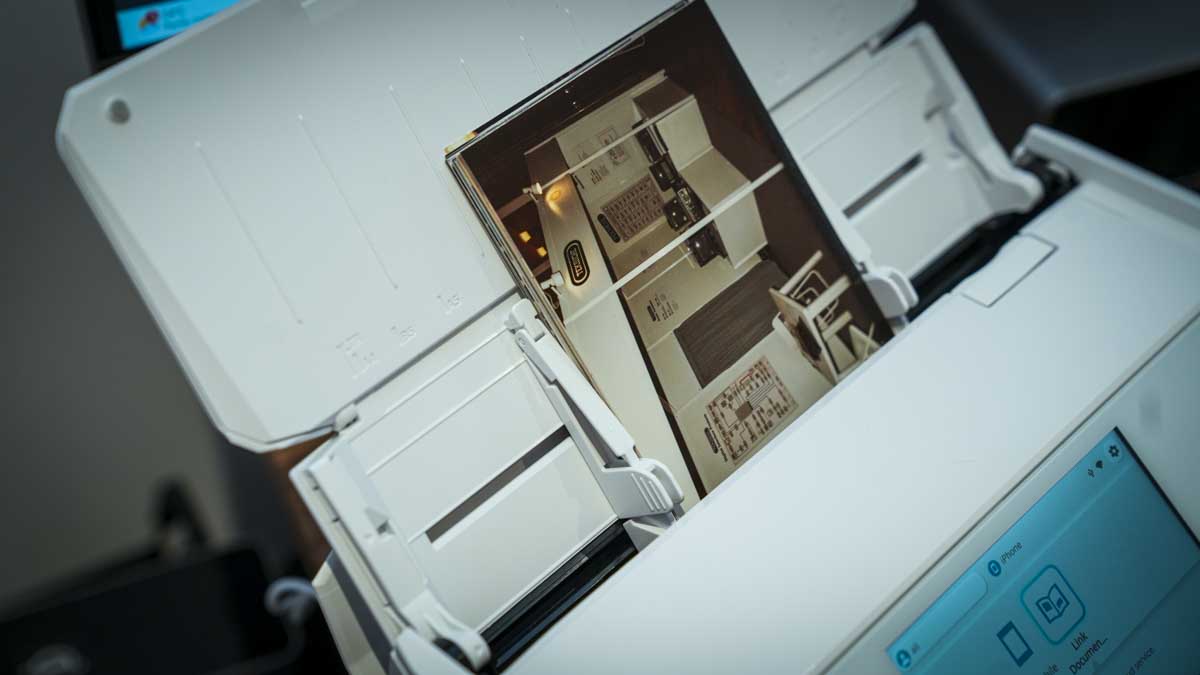
ScanSnap iX2500: Design

Storage: Saves to connected device or cloud
Ports: USB-C (USB 3.2 Gen 1)
Connectivity: Wi-Fi 6 (2.4/5 GHz), Bluetooth 5.2, USB-C
Size: 292 × 161 × 159 mm (11.50" × 6.34" × 6.26")
OS Compatible: Windows, macOS, iOS, iPadOS, Android, ChromeOS
Accessories: ScanSnap Home, ABBYY FineReader, Kofax Power PDF
The first impression of the Ricoh scanner iX2500 is the design resembles a compact and rather stylish desktop printer. It is essentially much the same form, with an auto sheet feeder at the top and an output tray at the base.
When the printer arrives the top lid, that doubles as the sheet feeder tray is folded down over the touchscreen, making a very neat and compact ensuring it will fit nicely on the side of a desk or on a shelf.
One of the great things about the design is that once set-up it can be used almost completely wirelessly, although AC power will be required.
When it comes to cables, there's absolutely no need to connect them directly to your desktop, laptop or mobile device, as aside from the power cable that goes into a wall AC socket, all interaction with the scanner can be done wirelessy.
When it comes to footprint, it measures 292 × 161 × 159 mm, ensuring it will fit almost anywhere, and weight-wise, whilst it is relatively heavy at 3.5 kg, its compact size makes it easy to handle and position.
The style is very minimalistic, and it certainly looks like a piece of office machinery, but with the tray and feeder both folding and sliding in, it makes a very neat unit that can be easily stored.
One of the features that really appeals to me when using the iX2500 is the large 5-inch touchscreen. As you fold the feeder tray up and over the top of the machine, it reveals the large touchscreen, which is used to quickly navigate through all the options and settings. Alongside the screen is the large scan button to the right, so when it comes to basic operation, it's really quick and easy to use.
However, there are a few things worth noting. The first is that this is not, and doesn't have the ability to be, a flatbed scanner, so if you require scans from books or any larger objects, you will still need to rely on larger flatbed scanner.
A small issue you might have, especially if it's sitting on a shelf, is that the hinged feeder cover does require a little bit of vertical height. Through the test I didn't find the height an issue, as you're going to have to feed through your documents anyway, so the fact that the cover opens up just gives those documents some support. It's worth noting, though, that while the machine might fit on a shelf for storage, it's going to need a little bit of vertical clearance so you can place the documents inside comfortably.
- Design: 4.5 / 5
ScanSnap iX2500: Features
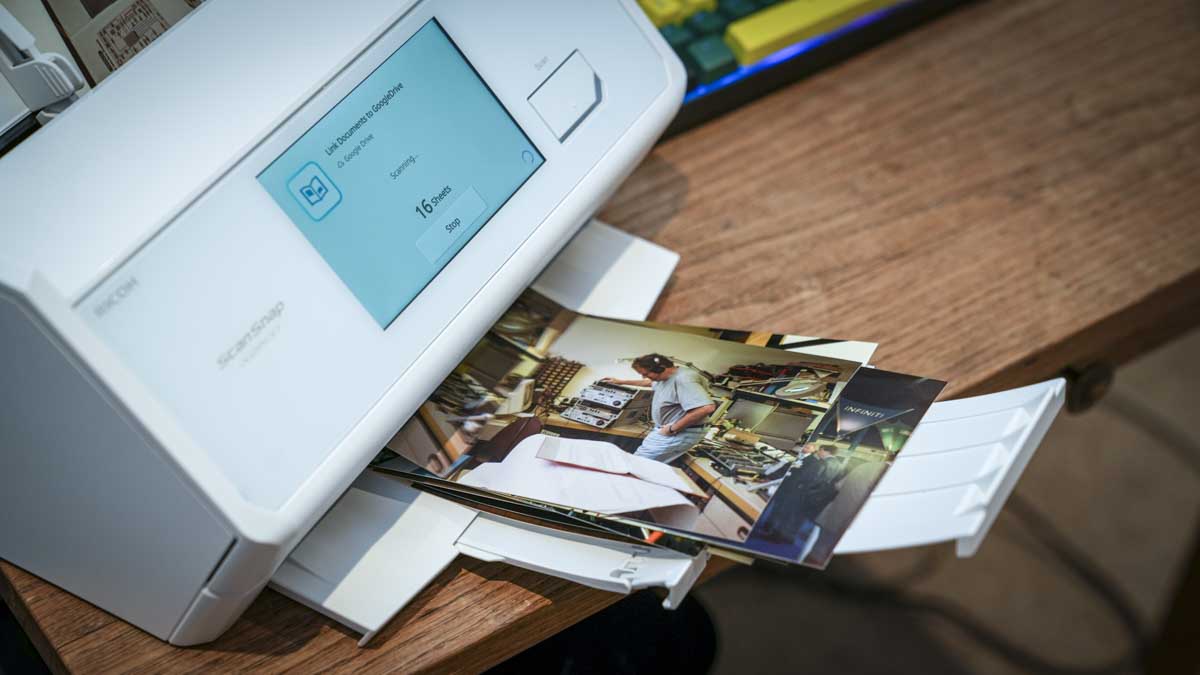
I've looked at a couple of ScanSnap scanners before, and each one impresses me with its ease of use and speed, and once again, the scanner iX2500 doesn't fail to impress. It's certainly something I'd want around the office if I had to do a lot of document scanning, and in fact, for the multiple import duty forms that I seem to have to fill in, this would be an ideal solution.
What impresses is that it offers both single and double-sided scanning, so with duplex scanning it can scan up to 90 images per minute, and with a 100-sheet ADF capacity, you can pile up a load of paperwork and the machine will automatically plough through it, exporting the files in whichever file format you have chosen.
When it comes to the paper size that can go through the machine, there's a wide variety, with the maximum size essentially being close to A4. Ricoh states that it supports a wide range of paper from 50.8 × 50.8 mm, which is incredibly small, to 216 × 360 mm, just above A4 size.
As the documents are scan and digitized, there are several auto features that can be activated within the software to help with the scanning quality and process. These include auto rotation, bleed-through reduction, and OCR, especially useful if you need to search documents for text and information.
Another feature I really like is that before scanning, you can set up a job so it scans the images to cloud storage. If that cloud storage is shared with other people, you can scan all your documents so people can access them online, which can be useful if you're working in a small business.
Again, another great feature is the OCR and PDF editing software that enables you to quickly convert the scanned image files into usable and sendable documents.
As ever, this is designed to be a generic office scanner, and so it is limited in the length of material that you can place through it. You also can't scan books, and longer materials will be limited to the scan length supported by the OS you're using.
When it comes to features, the main highlights are the easy connectivity with Wi-Fi, Bluetooth and USB, the large touchscreen which makes navigation exceptionally easy, and the 100-sheet feeder which enables you to batch process document scan jobs with ease.
- Features: 4.5 / 5
ScanSnap iX2500: Performance
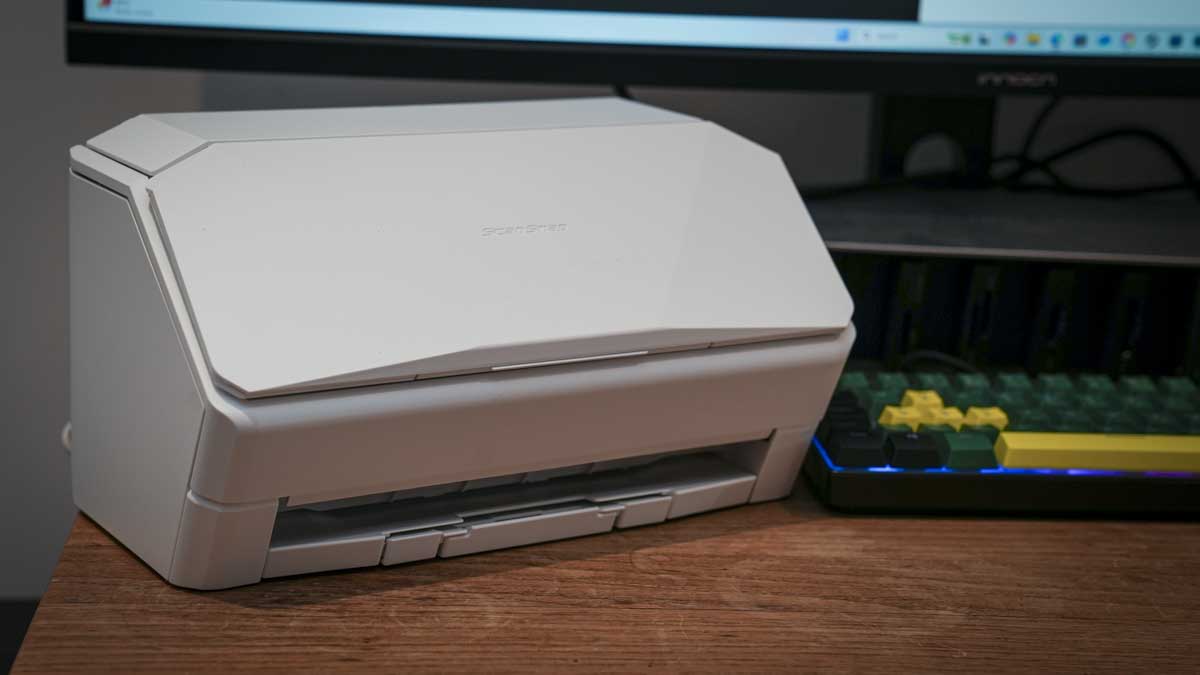
With more complex hardware devices, especially office gear, there's usually a bit of configuration required. However, with the Ricoh ScanSnap iX2500, connecting to my MacBook Pro M1 Max or to my iPhone 15 Pro was incredibly easy.
Once the software was downloaded and the scanner was switched on and connected to my network, it was instantly recognised and usable using the default options. Then all I needed to do was quickly go through the options on the touchscreen to change settings away from the default, which were already pretty decent, hit the large scan button, and the machine handled the rest, with the resulting quality of the document scans being exceptional.
Through the test, I put it through a series of old bank statements, MOT certificates and other paperwork that I'd been less than careful with, most slightly creased and some with folded corners. Even with the poor state of this paperwork, the ScanSnap was able to separate the sheets well and get decent duplex scanning. The only issue came when one of the sheets was folded in such a way that two sheets stuck together, at which point the machine paused with an error to alert me of a paper jam.
To be honest, this paper jam was slightly orchestrated just to see what would happen and how the machine would handle it, and I have to say once again, I was really impressed with the process and the workflow.
One of the issues I have had with these machines in the past is the amount of noise they generate, especially as they clunk as each new piece of paper is drawn through the machine. However, here the machine was quieter. You could still hear the motors as paper was drawn through the system, especially for duplex scanning, but it was far quieter than the iX1300 that I looked at earlier in the year.
What I really wanted to try with the iX2500 was the photo scanning, and this is a huge improvement over what I've seen before, both in the way that it draws the print through the system and also in the quality of the actual scan. I put in about 50 images, and it scanned through them at a relatively decent speed.
After that was completed, I then went back in and started to scan the documents using a higher setting. Here, I did notice a marked slowdown in the scanning speed, but after the process was completed, the actual quality of the scans was surprisingly good, really only hindered by the age of the prints themselves, although not up to the high quality of my flat bed imaging scanners.
One thing I would note is that whilst you can scan multiple images and it will draw them through the system well, especially with the improved document holder that better holds and clamps the paperwork in place, when they come through on the other side, the images tend to spill out. I didn't find this too much of an issue, but in a busy working environment, that could be a problem.
One thing I would once again say about the photo scanning on the ScanSnap iX2500 is that whilst it's fine for keeping a copy photographs, if you're looking for high-quality scans of family imagery or important documents, then I would think again. It's a shame that the resolution and quality aren't quite there for photographic archiving, although to be honest, this is for small businesses, where the quality of the image scans will be more than sufficient.
One of the features that appealed to me was the cloud save function, and in this test, I connected it up with Google Drive.
To do this, I had to go into the app on my iPhone and select destination, add a destination as a cloud, then set up the cloud consent options. One of the things here is you actually have to click on each of the agreements in order to complete the ScanSnap setup, so you can use the cloud storage. This can be a little hit and miss, and took me three or four attempts to make the connection. This was a bit of a surprise, and I think it was down to Google rather than the Ricoh software, as everything else in the ScanSnap app worked absolutely seamlessly.
However, once done, I could then scan using the scanner by just placing the documents in, as I had done when scanning the files over to my phone, but this time they were scanned up to the cloud server. This worked incredibly well, although one thing I couldn't work out was how to scan both to the cloud server and to the mobile device.
Obviously, you can access all of the images through your mobile device in the usual way through the Drive App. It's worth taking a little bit of time getting the cloud setup configured, as it isn't quite as straightforward as the rest of the use of this machine.
Once you have Drive configured, you can just place your photographs or documents into the machine, hit scan, and again, all of the documents scan quickly and are automatically uploaded to the Google Drive folder you specified. For me personally, this was one of the best features of this machine, and the one feature that really made me think about how useful this would be in my own office.
- Performance: 4.5 / 5

ScanSnap iX2500: Final verdict
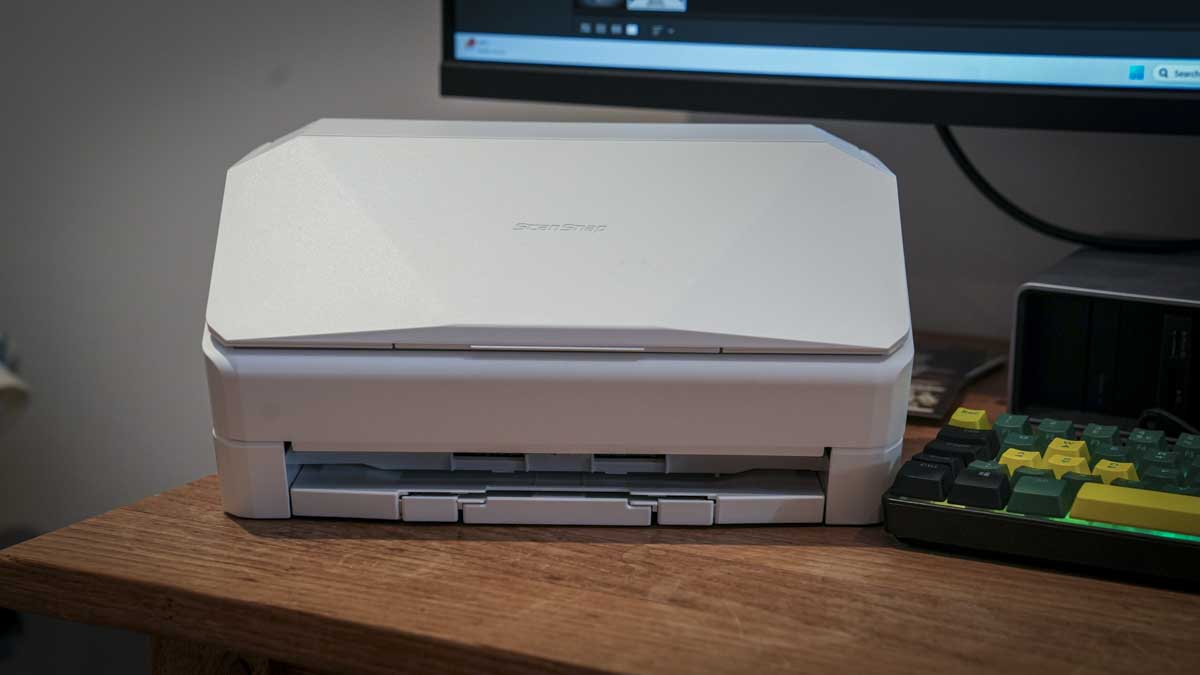
Since I reviewed the Ricoh scanner iX1300, I've realised just how useful that small machine was in the month that I had it, and now I've had the iX2500, I'm at that tipping point of thinking that this isn't just a machine that is great for a short period of time whilst I review, but is actually a really useful and integral part of the office.
Even when you're trying to work paperless, there are still documents that you want to scan and store. The fact that you can set up easy Drive folders so that all financial matters are quickly uploaded to the relevant folder online saves the sudden rush of paper scanning towards the end of the financial year.
Likewise, I have plenty of photographs that need scanning, and although I know this isn't going to be the best quality scanner, just the fact that I can quickly set it onto the highest quality setting and batch scan up to 50 images in a row and at incredible speed does make it useful.
Then there's the major factor that it has duplex scanning, so if you have a double-sided document, you can place that in and it will scan both sides into whatever format you want, then upload those either to your mobile phone, the desktop app or the cloud storage. It's just very integrated and easy to use.
I also like the multiple connection options, so if you want to go hard-wired, then a USB Type-C cable will connect your computer and the machine. If you want to go Bluetooth or wireless, then you can do that through the network as well.
You don't even have to be in the same room, and if you don't want any computer at all and you have the cloud storage set up, then all you need to do every time you want to scan anything is go to the machine, open it up, place your paperwork in and hit scan. By the time you get back to your computer, all of the files should be there, ready to review in your Google Drive or whatever platform you use in the specified folders.
When it comes to essential pieces of kit, I would like to think that we could go paperless, but I still have to have a printer, be that for package labels or for financial documents that I need to send off to accountants. Likewise, I often find myself needing to scan and still have a flatbed scanner, albeit about 20 years old, but this is a far more integrated option.
For any business that is growing and has paperwork that needs to be scanned and digitised, this is just a good option. There are, of course, a few downsides, as in you can't scan a book or anything too thick, this is a document and paper scanner. More critically, it is expensive. However, when you consider just how good it is, how fast and easy to use, I would definitely say this is well worth serious consideration if you need to do document scanning at work or even at home.
Should I buy a ScanSnap iX2500?
Value | This is a great machine, but it is over £500/$500 and on the expensive side, which will make it just out of reach for many people. | 4 |
Design | Great design that essentially enables it to pack down and easily store on a bookshelf or on the side of your desk, ready to go whenever you need it. | 4.5 |
Features | Packed with features, and that touchscreen really does make a difference to its usability, as does the cloud storage and sheet feeder. | 4.5 |
Performance | Absolutely superb for document scanning; I just wish the scanning was another step up in quality. | 4.5 |
Overall | Superb document scanner with a small footprint and decent quality, but it is expensive. | 4.5 |
Buy it if...
You scan documents regularly for work or personal use.
If you have plenty of paperwork scattered across your desk, floor and every surface in your office, then you definitely need this device, as it will enable you to quickly get through that paperwork and get it organised.
You want direct cloud integration without a complex setup.
This is the feature that really sold me on this particular model, and whilst it takes a little bit of fiddling to get the cloud storage set up, once you do, it's one of the best features you could possibly wish for when organising your documentation.
Don't buy it if...
You need to scan books, magazines, or fragile originals.
There's just no way you're going to stick a book or a magazine into the auto sheet feeder without jamming it up. For that, there is only one solution, and that is a flatbed scanner.
You frequently require high-resolution image scanning.
If this scanner were able to scan high-resolution colour and black-and-white images, even with a maximum size of A4, there would be no doubt that I would have gone out and bought one. Unfortunately, the quality is still rather limited.
For more office essentials, we've rounded-up the best home printers and the best scanner deals around.
Alastair is a photographer, filmmaker and tech writer who has been working in the publishing industry since the late 1990s. For more than 25 years he has covered photography, video and technology across Future's photography, technology and gaming brands. He runs a photography and video production company and lectures in TV and film. He can usually be found testing mini PCs or prototyping and prop building with the aid of 3D printing.
You must confirm your public display name before commenting
Please logout and then login again, you will then be prompted to enter your display name.
